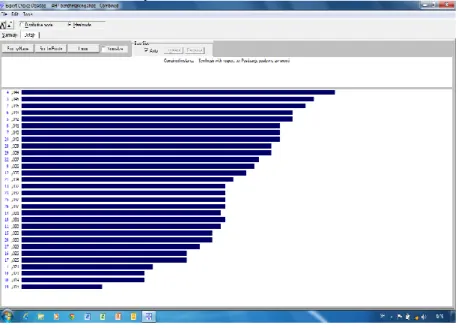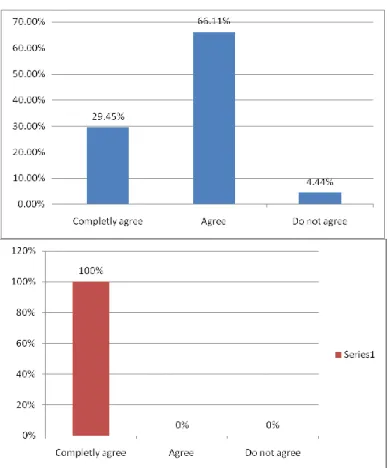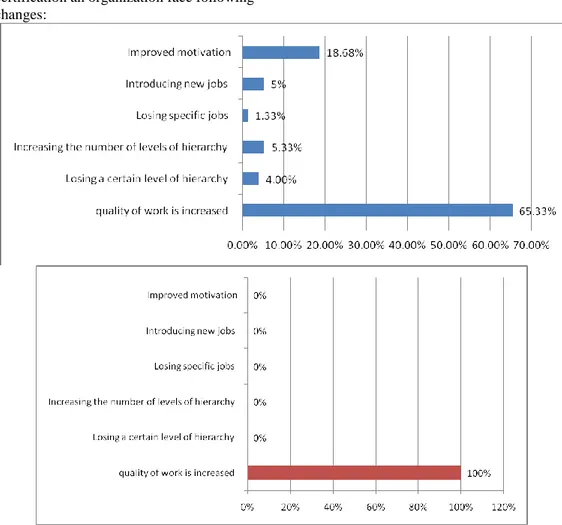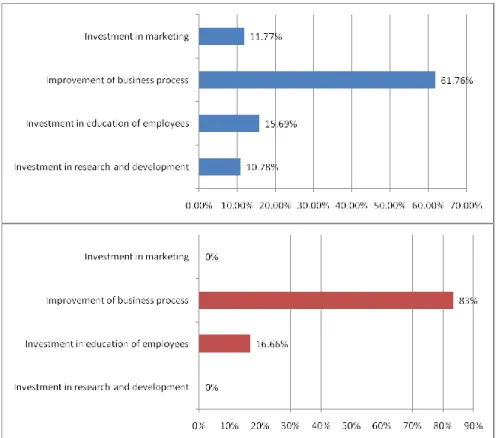7th International Quality Conference May 24th 2013
Center for Quality, Faculty of Engineering, University of Kragujevac
Aleksandar Vujovic
1)Zdravko Krivokapic
1)Jelena Jovanovic
1)Sanja Pekovic
2)Radivoje Micunovic
1) 1) Faculty of Mechanical Engineering, University of Montenegro aleksv@ac.me, zdravkok@ac.me,BUSINESS PROCESS IMPROVEMENT BY
APPLYING BENCHMARKING BASED
MODEL
Abstract: The choice of theme is identified by the need
to improve business processes in organizations, as well as the continuous improvement of overall quality, which is under-represented in the Montenegrin organizations. The state of Montenegro has recognized the growing importance of small and medium-sized organizations in the development of the national economy.Small and medium-sized organizations are the drivers of future economic growth and development of every country whose competitiveness has to pay special attention. One of the main sources of the competitiveness of small and medium-sized organizations is their pursuit to the business excellence, because it has become the most powerful means of achieving competitive advantage of organizations. The paper investigates certified organizations in Montenegro and their contemporary business and commitment towards business excellence.These organizations in Montenegro adapt its business to international standards and procedures that represent the future of economic growth and development of modern business. Research results of Montenegrin organizations were compared with small and medium-sized organizations from Serbia, which won the awards for business excellence "Quality Oscar" in the category of small and medium-sized organizations, for the last three years (2009, 2010, and 2011). The idea comes from the neccessity of Montenegrin economy to give small contribution in order that small and medium organizations ajust their businesses to the new business.
Keywords: benchmarking, business process
1. INTRODUCTION
In the new conditions the changes rapidly taking place, the success of any organization depends on its ability to quickly change and adapt to the real conditions in order to survive in the market. One such approach is also a commitment to the improvement and advancement of business processes, which
is the basis of the modern business world. The economy of Montenegro is striving to get closer to the Western European countries joining the EU, there will be a much stronger participation from leading manufacturers what induces that the organization in the domestic market must make considerable effort to maintain the current position in the domestic market and its presence in the EU. Therefore it is
very important that organizations use a variety of techniques and concepts of modern business improvement. The paper applied the concept of benchmarking, which is based on a comparison of Montenegrin organizations with leaders in the region that obtained "Oscar quality." In Montenegro, the most frequent menandžment quality system (QMS), but the tendency of organizations to the global market imposes the need for faster implementation of total quality menandžmenta (TQM). Expectations of this paper are directed towards promoting and deepening knowledge and skills in this field and their application in the development of business processes in Montenegrin organizations. All the reason for making this topic to be sought in the fact that this approach has been observed on the property, according to the authors' knowledge, is not represented in the national and international literature and practice.
2. BENCHMARKING – BASIC
CONCEPTS, DEFINITIONS AND
NEED FOR FURTHER
RESEARCH
Organizations, in order to assess their market position need always to compare their activities with other organizations. One of the modern method of comparing the organization and business improvement is benchmarking. Benchmarking is a systematic process of measuring and comparing the business processes of the organization in relation to the business processes of leaders. As part of strategic management, benchmarking company provides guidance to business processes, technical solutions, functions, and problems that could be improved. enchmarking is an integral element of the philosophy of total quality management (TQM) and continuous improvement culture business. In the literature, there are
different divisions of benchmarking and the most common are: internal, external, functional, competitive and generics. In order to seek to be the best of the best, and in order to achieve superior performance in the study, we combined benchmarking elements (internal and external). Internal benchmarking will identify a process, activity, data and information, which will be the subject of improving the business process of Montenegrin certified organization, we made a comparison of external organizations in the region award winners for Business Excellence, in order to obtain important information about competitors' business (processes, logistics, innovation , business culture, etc.). The aim of comparison is to determine the ideal business, as this form of benchmarking process provides opportunities to achieve outstanding business results. In most of the published papers showing the process of benchmarking at the global and / or detailed level. At the global level, implementation of benchmarking can be viewed through a number of phases, and the detailed level to describe the individual steps of implementation. Main stages of the benchmarking process which caused by APQC, the EFQM - and other companies are: I Planning, at the beginning of the research is necessary to do an analysis of the entire company as a whole to determine where to apply the benchmark, II Collection of information at this stage is the collection of all companies selected in the previous stage. III Benchmarking Analysis team at the company handles all the data and they form the basis of the final report. The report contains a selection of benchmarks, ie, benchmark partners. IV Application of the company started with the implementation of changes resulting from the benchmarking study. Benchmarking has great advantages over conventional methods of improving the company's business, such as: continuous improvement
of operations, increased competition in the market, overcoming poor performance, increases profits. However it has disadvantages which are primarily related to the lack of understanding of the essence and research techniques.
3. BUSINESS EXCELLENCE, AND
MODEL SELECTION FOR
RESEARCH
Every year, more and more countries introduce quality awards and more and more organizations take part in competitions for prize money. Business Excellence is based on a system of total quality management (TQM - Total Quality Management). Business excellence is a way of doing business that enables organizations to achieve balanced satisfaction of all stakeholders (customers, employees, shareholders and society). The notion of business excellence should be seen as an expression of the highest quality and reliability. World-class organizations are the ones that generate consistent, measurable and positive results based on the introduction of philosophers of continious improvements, ie. their ability to constantly introduce changes. They are
distinguished by the following
characteristics: determination of
management, employee motivation,
customer satisfaction is very high, stable and rapid growth market share, operating results that contribute to the rankings. For the application of business excellence models that we use models that derived from the prestigious Quality Award (international, national and company awards) for improving the quality of the TQM model. The most important are: in Japan The Deming Prize, in America - Malcolm Baldrige National Quality Award (MBNQA) in Europe - European Business
Excellence Model for Quality
Management (EFQM), the European Business Excellence Model is today's most
powerful model, which is widely accepted and used by many manufacturing, and
service, large, medium and small
organizations, profit and non-profit.
"Oscar quality" is an award for business excellence by the model of the Fund for a culture of quality and excellence (FQCE), awarded to for-profit and non-profit
organizations for outstanding results
achieved in improving the quality of development in Serbia. Model award is modeled based on the European Quality Award, contains nine criteria with a maximum of 1000 points which are awarded in two categories: small and medium sized organizations and large organizations category. FQCE, review and monitor all the changes taking place in the European EFQM. "Oscar for" from the aspect of this work is totally complement the European Quality Award (EFQM) and as such can be used in this paper. For the purpose of referring business excellence award winners "Oscar quality" for the period of 2009, 2010 and 2011.
4. RESEARCH METHODOLOGY
The starting point for this research paper is 125 small and medium-sized certified organizations in Montenegro. Further research considered a sample of 60 certified organizations. The main research for this paper was carried out on a sample of seven small and medium organizations in Serbia, winner of the Business Excellence Award "Oscar quality" in the category of small and medium-sized organizations, for the last three years (2009, 2010 and 2011). The questionnaire contains 52 questions, and it is the backbone of all of this research. Reviewing business processes through research facility in the first phase, we obtain a set of data representing characteristics of our operating systems in terms of certification and questionnaires. It forms the basis for building work andcompare to the benchmark. When it comes to the second level of data that is a benchmark for comparison, the elements of research are organizations that have received a national award for business excellence "Oscar quality." This awards 90 - percentage amount is consistent with the model of the European Award of Excellence - EFQM business excellence, and therefore the results can be applied to a large extent on a broader level. Data were obtained on the first and the second level is unique and as such contribute to the elevation of the quality and significance of the results. Based on the research of the second level of the data makes the same questionnaire and expert assessment criteria for business excellence, and in this way a basis for comparison of the data with the first-level and second-level data or benchmarks. For the purposes of the evaluation we obtained information from four experts, who possess the expert knowledge and experience in the field of quality management systems, and business excellence and their grades can be taken as the final results of this landmark study. After the score obtained by experts, using the Pareto methodology and AHP methods we get the model coefficients significance in achieving the requirements of business excellence. The purpose of the research is to determine the most important elements of business processes in organizations surveyed and certified in Montenegro in relation to the winners of awards for business excellence "Oscar quality." Then to indicate the current state of the organization in Montenegro, and give guidance to improve the criteria and sub-criteria for the basic principles of business excellence in Montenegro. It starts from the premise that organizations in Montenegro are not sufficiently familiar with the business models of excellence, nor their potential positive effects. On the other hand we talk about the benefits of business excellence, given to organizations that are striving for business excellence are
or will be competitive compared to those organizations that are not certified or engaged enough to follow the trend of modern business. On the basis of these objectives we propose two hypotheses:
H1.Using benchmarking methods and expert multi-criteria decision an organization can build a model for improving its performance.
H2. Based on the criteria of the European Business Excellence Award and on the model for improving organizational performance an organization can defined priority areas and measures to improve the its operations. The paper applied scientific research methods: The method of analysis was used in the research in order to make less complex concepts and opinions, simpler segments and factors. In solving the problem of synthesis of the priorities will be the criteria, sub-criteria that will give the overall priorities of the alternatives. The data for this study obtained both opinion polls - a survey form. The questionnaire consists of two parts (general and professional). To rectify the shortcomings in the survey, has decided to collect data and perform interviews.
Tools and quality technics that are used: Pareto method (ABC) and Rule 70%/30% were separated strongest requirements in achieving business excellence, and these will be considered as the final result, and based on that will give suggestions to improve business processes. To determine the level of significance of individual criteria towards achieving business excellence model by Academy Award quality, the methodology applied is AHP (Analytic Hierarchy Process).
Following the evaluation criteria of each expert, the end result was obtained with a significance level using AHP. Data entry and processing is carried out partly through working in MS Excel initial part of the data collection, calculation and allocation of the percentage display. The second part was performed entry and
processing of data pertaining to the application of expert assessment methodology and the associated AHP software Expert Choice. On the basis of expert evaluation and a basic level of connectivity with the level of data extraction was performed only for those issues (and associated data) that can give adequate and appropriate answers or results. In this paper assessment is done on two levels:
LEVEL I - Assessment of the relationship of selected issues (area / area of a system) and the criteria for business excellence awards.
LEVEL II - Assessment of the level of significance of certain alternatives in relation to its objectives. In terms of implementation of the AHP methodology, as well as award criteria in relation to the object, which is to achieve business excellence, we used weights that are already assigned to each criterion. The assessment of the level II, the obtained results are taken into account when defining the significance of alternatives that are given in the individual questions.
This level of evaluation is useful in the analysis of the results.
5. RESEARCH RESULTS
To determine the level of significance of some issues that are specific areas in terms of achieving business excellence model by Oscar quality AHP (Analytic Hierarchy Process) methodology was applied. For the purposes of assessment in accordance with the multi-criteria decision-making using the AHP methods, the assessment was made by the experts. After the implementation of the methodology results obtained are presented in Figure 1. Applying Pareto diagram ABC rules and 70% / 30% as the most important requirements in achieving business excellence, we can single out the areas defined question: (4, 3, 2, 5, 24, 28, 29, 22, 12, 21, 23 , 25, 26.14 and 11), and will in future work to put emphasis to these issues.
Figure 1. Coefficients of significance
the region awarded by winners for Business Excellence, are presented in diagrams that follow. On the left is the certified organizations from Montenegro, and the experiences of organizations from right environment for business excellence. In areas that are part of the AHP methodology allocated most important are those that have expressed indicative of variations and differences (differences fundamentals and benchmarks). For these areas was conducted and analysis,
measures for improvement in order to uplift the level of performance to that of exercising.
AREA:3
Top management considered and accepted ideas and suggestions employees: a. Completly agree
b. Agree c. Do not agree
Figure 2. Coefficients of significance: 0,046 When we look at this area to see the
organization in full use, understand and recognize the benefits and potential employees. In this regard the organizations of Montenegro should develop their organizations to review and accept the suggestions and proposals of employees
who are important to the organization. Possible suggestions for organizations to use the potential of employees can be made through:
● awareness of employees, their training and development, redeployment ● employees, according to their
professional qualities,
● employee involvement in the activities of the permanent improvements
AREA: 24
After the implementation of ISO 9000 certification an organization face following changes:
a. quality of work is increased b. Losing a certain level of hierarchy c. Increasing the number of levels of
hierarchy
d. Losing specific jobs e. Introducing new jobs f. Improved motivation
Figure 3. Coefficients of significance: 0,040 In this area we can see a significant
difference of the quality organization in the region that improves quality management system implementation, then key management processes and continuous improvement of management processes tend to maximize the satisfaction of the consumer and that is one of the important criteria business excellence. The direction
of the organization towards business excellence in Montenegro should certain influential factors krterijuma excellence adapt its business and especially the leadership and leaders who will be their active participation will inspire, support and promote the culture of total quality management (TQM). Possible mechanisms for the strengthening of these activities are:
Identify areas for improvement, Constantly perform continuous
process improvement,
Use quality tools for continuous improvement,
Conduct periodic follow training, testing, employees and others.
AREA: 14
What did mainly contribuate to commercialization of new products and/or services?
a) Investment in research and development
b) Investment in education of employees c) Improvement of business process d) Investment in marketing
Figure 4. Coefficients of significance: 0,036 Looking at this issue, we see that
organizations in the region have a potential to improve their business, so they give a good knowledge of the importance of commercialization and recognize the constant need to improve business processes in order to survive in the market. Organizations in Montenegro must act in this direction, try to develop a new product that would strengthen the capacity of
business and were keeping up with competitors. Factors to strengthen these activities are:
improve business processes for new product development,
to monitor and analyze market development
to monitor, analyze and predict consumer behavior and development,
to improve processes for continuous improvement of product quality continue to develop and improve
products and processes.
6. CONCLUSION
The findings of this study leads to the conclusion that the quality of excellence and the quality are the key to the success of any organization. Business excellence has become the most powerful means of achieving competitive advantage of organizations and total quality management ensures that time and supports outstanding results in the future. National Award for quality plays an important role in promoting and rewarding excellence in organizational performance, raises the quality standards of organizations and profiles of the country as a whole. All indications are that neither the region nor the world has been pursued and implemented in this analysis, which is given as a result of the most critical areas that should be done to improve performance of business processes, based on the analysis of literature sources, and preliminary studies on the topic that we have covered. The data used in this paper are unique. It is obtained on real indicators from organizations that operate in real-world conditions. Therefore the results are values significantly and reflect the real situation of our organization. Data to be analyzed are the property of the organization and external assessment bodies of business excellence, and as such are presented in an encrypted (protected) form with a statement of adherence to the principle of absolute discretion. The methodology is general and the results can be applied to similar areas of business conditions outside Montenegro. Thus defined approach is reflected in the fact that data relating to certified organizations in Montenegro and organizations in the region - the winners of awards for business
excellence. Concerning the work we do only research organization certified by a series of international standards ISO 9000, and how these standards are general, and the results are to be understood as applicable to similar general business conditions. At the second level of data the author has chosen the Business Excellence Model for Oscar quality, and for reasons of availability. This model is almost identical to the European model of business excellence awards, so in that sense we can speak of the generality of the data and results and conclusions.
In order that organizations from Montenegro lift the performance level of priority, they should:
Encourage and involve employees to develop their ideas in order to improve operations in accordance with the purpose and strategy of the organization
Use quality tools in accordance with the requirements set business excellence
Encourage employees to take initiative Development of innovative ideas, and to recognize the efforts of individuals or teams on successful projects Support and promote the culture of
total quality management, identify areas for improvement and use of quality tools for continuous improvement of business processes environment that provides managers
and leaders rely on the skills, knowledge, and talent of employees, to organize training, seminars and specialization (for employees ), as well as to constantly monitor the development of new technologies and their application
invest in the development and modernization of the organization, the importance of optimal use of new - Technology Development
Improve business processes for new product development, monitor and analyze the development of the
market, monitor, analyze and predict the development and consumer behavior, improving processes for continuous improvement of product quality.
Based on the findings and analysis in terms of the hypothesis, it can be stated as follows:
1) This paper develops a model that combines benchmarking methods and multi-criteria expert decision on the
basis of which they can achieve organizational improvements which confirmed the first hypothesis. 2) Using this model and the certified
organizations that won the awards for business excellence are defined priority areas for improvement and measures to be taken in order to achieve improvement thus confirming the hypothesis of two.
REFERENCES:
[1] Krivokapić, Z. (2011). Sistem menadžmenta kvalitetom. Mašinski fakultet Podgorica. [2] Perović, M. (2003). Menadžment - informatika – kvalitet. CIM Centar, Mašinski fakultet u
Kragujevcu.
[3] Vujović, A. (2008). Poboljšavanje performansi poslovnog sistema na bazi sistema
menadžmenta primjenom vještačke inteligencije (Doktorska disertacija, Mašinski fakultet,
Podgorica).
[4] Perović, M., & Krivokapić, Z. (2007). Menadžment kvalitetom usluga. Mašinski fakultet Podgorica.
[5] Mašić, B. (2009). Strategiski menadžment. Beograd Univerzitet. [6] Radivojević, G., & Miljuš, M. (2004). Benčmarking i logistika. Beograd. [7] Inić, B. (2008). Strategic Menagement. Beograd.
[8] Boxwell, R. J. Jr. (1994). Benchmarking for Competitive Advantage. New York: Mc Graw-Hill.
[9] Sajferl, Z., & Adamović, Ž. (2004). Menadžment benčmarking proces. Zrenjanin: TF Mihajlo Pupin.
[10] Vujović, A. (2004). Makroupravljanje neusaglašenostima kao osnova modela za
poboljšavanje QMS- a, (Magistarski rad, Mašinski fakultet, Podgorica).
[11] Jovanović, J. (2009). Model unapredjenja sistema upravljanja zaštitom životne sredine
primjenom multisoftvera. Podgorica: Univerzitet Crne Gore.
[12] Petrović, S. (2011). Analiza inovativnosti i inovacija u sertifikovanim organizacijama (Magistarski rad, Mašinski fakultet, Podgorica).
[13] Fond za kulturu kvaliteta i izvrsnost (FQCE), Beograd, 2010.
[14] European Fozundation for Quality Management Self– Assessment Based on the European Model for Total Quality Management, Brussels, 1994.



